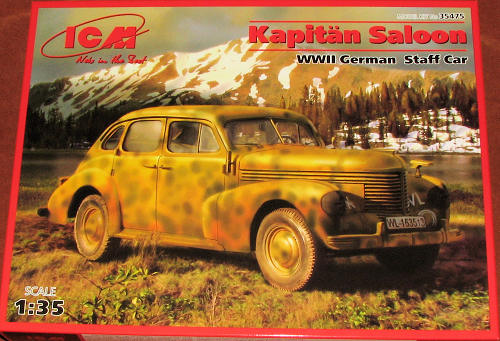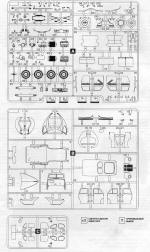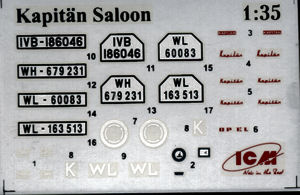
ICM 1/35 Opel Kapitan Saloon
| KIT #: | 35475 |
| PRICE: | $37.95 SRP |
| DECALS: | Four options |
| REVIEWER: | Scott Van Aken |
| NOTES: | New tool kit |

| HISTORY |
The Kapitän was the last new Opel model to appear before the outbreak of the Second World War, developed during 1938 and launched in the spring of 1939 at the Geneva motor show. The first Kapitän was available in many different body styles, the most popular one being the 4-door saloon. 2-door coupé cabriolets were also built. The pre-war Kapitän featured a unitary body, a modern feature for its time. The car inherited its 2.5-litre engine from its predecessor: in this application a maximum speed of 118 km/h (73 mph) was reported.
Civilian automobile production by Opel ceased in the Fall / Autumn of 1940, by which time 25,371 Kapitäns had been produced: a further three were assembled during 1943, giving a total production volume for the version launched in 1939 of 25,374. In addition, 2 were assembled in 1946, and one in 1947, but these were not officially recorded in the statistics.
Included in the production total were 248 of the two-seater cabriolets built for Opel by independent coach builders Gläser of Dresden and Hebmüller of Wülfrath in Wuppertal. There would, however, be no resurrection for the cabriolet Kapitäns in 1948 when the sedan / saloon version was reintroduced.
| THE KIT |
 This
adds to ICM's growing catalogue of military vehicles and is a nice addition to
their staff car series. I like these sorts of things as they can also be built
as a civilian vehicle. Thankfully, quite a few of these survived so the Internet
can supply some color information for the latter.
This
adds to ICM's growing catalogue of military vehicles and is a nice addition to
their staff car series. I like these sorts of things as they can also be built
as a civilian vehicle. Thankfully, quite a few of these survived so the Internet
can supply some color information for the latter.
ICM's Kapitan is a well detailed kit that includes not only a full engine, but also a highly accurate chassis and interior. Building the six cylinder engine takes up the first part of construction. The kit has a full chassis that fits under a body that is constructed from a rather large number of components. For instance, there is a flat floor onto which both inner and outer fender panels are attached. The front cowl piece includes the windscreen area. Up front, both inner and outer fenders are separate constructs. The hood area is built up of two sides and an upper section onto which the front piece with the grille and headlights is attached.
These cars did not have very complex interiors.
Just a couple of bench seats with a nicely detailed instrument panel. The pedals
 are
molded into the floor section so one simply adds the stick shift. I found it odd
that the steering wheel was made of two parts, with the wheel being separate
from the spokes and shaft. Each door is made of two pieces and one trps the
clear windows between the halves. All the inner door parts (arm rest, window
winder, door handle), are separate pieces.
Also separate is the door post and the rear side window panel. The trunk
and upper body are also separate pieces. None of the doors, hood or trunk are
shown to be able to be opened, though it should not be that difficult for most
modelers to do so.
are
molded into the floor section so one simply adds the stick shift. I found it odd
that the steering wheel was made of two parts, with the wheel being separate
from the spokes and shaft. Each door is made of two pieces and one trps the
clear windows between the halves. All the inner door parts (arm rest, window
winder, door handle), are separate pieces.
Also separate is the door post and the rear side window panel. The trunk
and upper body are also separate pieces. None of the doors, hood or trunk are
shown to be able to be opened, though it should not be that difficult for most
modelers to do so.
Markings are for four cars. One is a civilian vehicle in gloss black from 1940. Next is a white one from Russia in 1942. A panzer grey version from Russia in 1943 is the third option while the fourth is from Italy in 1943. This last one is the box art car. While the instructions say panzer grey and green splotches, I think the box art is closer to how it should be. The decal sheet provides license plates and stencils when needed. I have darkened the sheet image so the white parts will be more visible.
| CONCLUSIONS |
This is another very nicely molded and well detailed car kit from ICM. I like that these sorts of kits are making an appearance, not just because I like staff cars, but because it provides some 1930s civilian vehicle possibilities as well.
| REFERENCES |
http://en.wikipedia.org/wiki/Opel_Kapit%C3%A4n
August 2012
Thanks to Squadron Products for the preview kit. Your local shop should have this one. If not, have them order it for you.
If you would like your product reviewed fairly and fairly quickly, please contact the editor or see other details in the Note to Contributors.